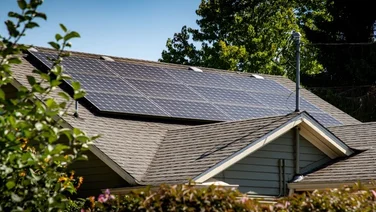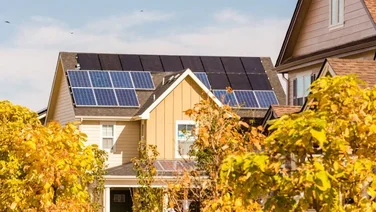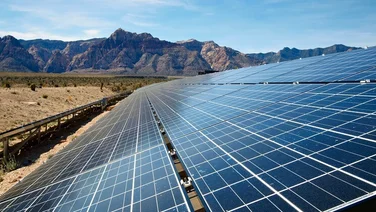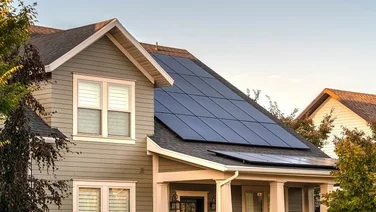- What is a solar battery?
- How much does a solar battery cost?
- When will you break even on a solar battery?
- Are solar batteries expensive to maintain?
- Advantages and disadvantages of solar batteries
- Getting the most out of your solar battery
- Are there any government grants for solar batteries?
- Will solar batteries become less expensive over time?
✔ A solar battery costs $8,500, on average
✔ Solar-plus-storage can save you $1,062 per year
✔ You can save 30% on costs with the Clean Energy Credit scheme
Getting a solar battery is a great way for you to cut your energy bills while reducing your emissions.
A solar battery will help you make the most out of your solar panel system, meaning you can take advantage of electricity generated in the day to use at night.
In this guide, we’ll tell you how much you’ll typically pay for a solar battery, how soon you could break even, which government grants could help, and whether solar batteries will get less expensive over time.

What is a solar battery?
A solar battery helps you store excess electricity generated by solar panels, so you can power your home when the sun goes down.
Even with solar panels and a solar battery, you won’t be able to completely remove your reliance on the grid.
You will drastically reduce how much you use the grid though, with the average household cutting its grid electricity by 73%.
A 4 kilowatt (kW) system will typically generate 22 kW per day , and US homes usually consume 30 kW per day.
The downside is the upfront cost and the long time it takes to break even — more on these points below.

How much does a solar battery cost?
You will pay $8,500 on average for a typical lithium-ion solar battery, not including installation.
You’ll also need to buy another solar battery before the end of your solar panel system’s lifespan, as it will last 10–15 years, compared to your solar panels’ 25-year life expectancy — bringing the total battery cost to $17,000.
Other types of solar batteries such as lead-acid models are much cheaper, typically costing $200–$400, but they are only suitable as backups for RVs and for use in small camping applications.
They require more maintenance too and don’t have near the same capacity as lithium-ion batteries, making them bad choices to use in a home with solar panels.
When will you break even on a solar battery?
You’ll break even on a solar panel system that includes a battery in 18.5 years.
A solar battery lasts 10–15 years, which is less than the average 25-year lifespan of solar panels. So you will need to purchase a second battery in a decade or so, bringing the total average cost for solar batteries to $17,000.
Getting a 4 kW solar panel system to go with your batteries will set you back $11,080 on average, bringing the total to $28,080. That’s without the federal solar tax credit of 30% — with it, you’ll only pay $19,656 for solar-plus-storage.
The average cost of electricity in the US is 15.42 cents per kilowatt hour (kWh), so without solar panels, grid electricity you’d spend an eye-watering $41,051 on grid electricity over 25 years — which is $1,642 per year.
Having a 4 kW solar-plus-storage system will save you $1,062 every year on average, which amounts to $26,554 after 25 years.
Divide the total cost of the solar panel system after 25 years by the annual savings, and you get a break-even point of 18.5 years.
That’s a long time to wait to make your money back, but you’ll still get enormous benefits from generating your own clean electricity.
Are solar batteries expensive to maintain?
Lithium-ion batteries, the most popular type of solar battery for US homeowners, require almost no maintenance at all.
Beyond a bit of light dusting and the occasional check up to make sure they’re holding charge properly, you can safely leave your solar battery alone.
A quick note on charge: don’t worry if your battery starts to lose charge capacity over the years — this is totally normal and expected.
You should still check that your battery’s charge degradation matches the warranty, which will guarantee you a set percentage of charge capacity after a certain number of years — for example, an 80% charge capacity by year 10.
Advantages and disadvantages of solar batteries
Here are the main pros and cons of solar batteries:
Getting the most out of your solar battery
Maintenance might be minimal, but there are other factors to keep in mind to get the most out of your battery.
Depth of discharge
This measures how much of your battery’s charge you should use before recharging it.
If a solar battery has a 10 kW capacity and an 80% depth of discharge, you should only use 8 kW before recharging it again.
And if you used all of the energy stored in your battery, that would be a 100% depth of discharge.
You’ll typically want to avoid this, because doing so can cause the charge capacity to degrade at a faster rate than is normal.
Many newer lithium-ion solar batteries, such as the Tesla Powerwall 2, have a generous depth of discharge between 90 and 95%.
Battery cycles
Each time you discharge and recharge a battery, this counts as a single cycle. Solar batteries have a set number of cycles before they start to degrade.
Lithium-ion solar batteries are designed for daily use, much like the batteries in our phones and laptops. So you don’t need to be very careful with how often you discharge and recharge — but it’s something to keep in mind when the battery starts to reach the end of its lifespan.
Check your warranty to see how many cycles your battery is expected to last through. If it’s 5,000 cycles, you can safely assume your battery can withstand one cycle per day for roughly 13 years.
Are there any government grants for solar batteries?
The Clean Energy Credit is a federal grant that gives customers up to 30% off a solar system purchase, including solar batteries, as long as the battery is charged exclusively with solar energy.
Just install your solar-plus-storage system before 2033 to benefit from the full 30% discount, which will save you thousands of dollars.
If you install a solar-plus-storage system worth $28,080 — $11,080 for the solar panels, $17,000 for two storage batteries — you can save $8,424 with the Clean Energy Credit initiative and pay just $19,656.
Getting a solar-plus-storage system installed after 2033 means you’ll only receive a tax credit worth 26%. It drops to 22% in 2034, and in 2035, the Clean Energy Credit initiative will end.
Other state-specific solar incentives exist, so be sure to check before you make a purchase.
Will solar batteries become less expensive over time?
It seems like the current supply chain issues affecting metal prices – and a soaring demand for electric vehicles – means lithium-ion battery prices won’t drop until at least 2024.
The record-high demand for lithium right now means prices might actually go up before they go down — a rise of 5% in the cost of solar batteries is widely predicted in the next few months.
This leaves homeowners who are looking to buy a solar battery with a choice: either bite the bullet and invest in a solar battery now, or wait a couple of years for prices to stabilize or fall.




